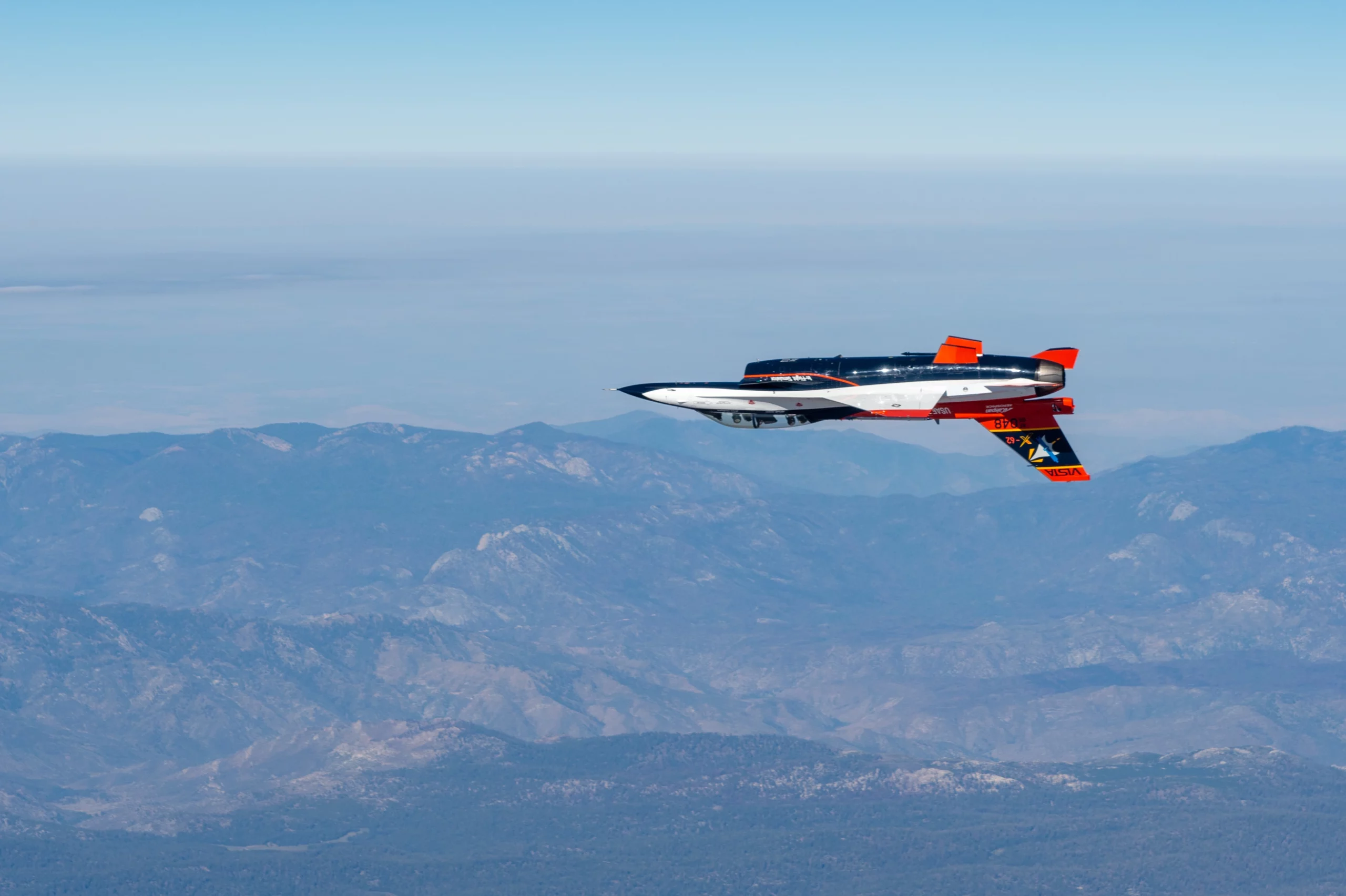In an unprecedented achievement, the Defense Advanced Research Projects Agency (DARPA), in collaboration with the U.S. Air Force, has announced that through its “ACE” program the X-62A “VISTA” has become the first autonomous fighter jet in the world to successfully engage in aerial dogfighting maneuvers against a manned F-16.
This historic event marks a significant milestone in applying artificial intelligence (AI) and machine learning in combat scenarios, highlighting a radical advancement in military aviation technology.
“The X-62A Team demonstrated that cutting-edge machine learning-based autonomy could be safely used to fly dynamic combat maneuvers,” Secretary of the Air Force Frank Kendall said in a video released by DARPA marking the achievement. The team accomplished this while complying with American norms for safe and ethical use of autonomous technology.”
The X-62A’s recent accomplishment represents a major breakthrough in DARPA’s Air Combat Evolution, or “ACE” program. The primary goal of ACE is to enhance trust in autonomous combat systems by focusing on the challenge of enabling an AI-controlled aircraft to engage in fast, within-visual-range aerial combat, commonly referred to as “dogfighting.”
Since its inception in 2019, the ACE program has rapidly reached several key milestones, marking a significant departure from the usual lengthy timelines associated with developing advanced aerospace platforms.
In 2020, DARPA’s ACE program hosted the “AlphaDogFight” trials, a three-day virtual competition where AI programs from various industry partners competed in simulated dogfight scenarios. Maryland-based software company Heron Systems emerged as the winner, outperforming seven other AI agents designed to control F-16s. These competing programs included entries from major defense firms such as Lockheed Martin and the Georgia Tech Research Institute.
Heron Systems’ F-16 AI agent would then go on to dominate a series of dogfights against an experienced human Air Force F-16 pilot, “winning 5-0 through aggressive and precise maneuvers the human pilot couldn’t outmatch.” In 2021, Heron Systems was acquired by Shield AI, a San Diego-based technology company that specializes in the development of AI-powered defense systems.
The previously computer simulation-bound AI program was subsequently uploaded into a modified F-16D multirole fighter aircraft, known as the X-62A “Variable Stability In-flight Simulator Test Aircraft,” or VISTA.
Developed by Lockheed Martin Skunk Works in collaboration with Calspan Corporation, the X-62A is a one-of-a-kind experimental aircraft outfitted with software that allows it to mimic the performance characteristics of other aircraft. The VISTA is used as a testbed for new systems, notably contributing to the development of the Direct Voice Input and the “Virtual HUD,” which have been incorporated into the cockpit design of the F-35 Lightning II.
During joint testing in 2022 at the Air Force Test Pilot School at Edwards Air Force Base, California, DARPA’s ACE program and the Air Force Research Lab’s (AFRL) Autonomous Air Combat Operations (AACO) system successfully piloted the X-62A, racking up more than 17 hours of flight time while autonomously executing advanced fighter maneuvers.
“We conducted multiple sorties [takeoffs and landings] with numerous test points performed on each sortie to test the algorithms under varying starting conditions, against various simulated adversaries, and with simulated weapons capabilities,” DARPA ACE program manager, Air Force Lt. Col. Ryan “Hal” Hefron, explained. “We didn’t run into any major issues but did encounter some differences compared to simulation-based results, which is to be expected when transitioning from virtual to live.”
In 2020, the Air Force tested an AI algorithm named “ARTUµ” to control the sensor and navigation systems of a U-2 “Dragon Lady” spy plane. However, the 2022 tests with the X-62A represented the first time a machine-learning program had ever been used to pilot a tactical fighter aircraft.
Less than a year after these groundbreaking tests, the ACE program has achieved another significant milestone by showcasing the AI-controlled X-62A’s ability to successfully engage in real-world dynamic, offensive, defensive, and high-aspect air combat scenarios against crewed F-16s.
According to DARPA, initial testing of the AI-controlled X-62A against human fighter pilots began in late 2023 and continued into 2024.
“In September 2023 we accomplished another world first where we actually took the x62 and flew it against a live manned F-16,” Lieutenant Colonel Maryann Karlen, Deputy Commandant of the U.S. Air Force Test Pilot School explained. “We built up in safety using the Maneuvers first defensive, then offensive, and then high aspect nose to nose engagements where we got as close as 2,000 ft at 1200 miles-per-hour.”
The recent announcement showcases the ACE program’s rapid progress from simulations to real-world applications and serves as a testament to machine learning’s potential to revolutionize air combat tactics and strategy.
The image of an autonomous, AI-controlled fighter jet engaging in dogfights with human-piloted aircraft is bound to capture widespread public attention. However, at the core of this breakthrough lies the significant advancement of machine learning technologies and their ability to handle a spectrum of highly complex tasks.
Machine learning stands apart from traditional, rule-based autonomous systems in its ability to learn and adapt from vast streams of data. Unlike pre-programmed systems that operate within strict parameters, AI algorithms like those developed in DARPA’s ACE program autonomously analyze data to make real-time decisions during flight. This capability mirrors how human pilots react instinctively to dynamic combat scenarios, continually learning and adjusting tactics based on experience.
A crucial aspect of integrating AI into practical aviation scenarios is establishing trust. DARPA says the ACE program has made significant strides in this area by ensuring the AI agents controlling the X-62A operate within aviation safety norms. These include aerial and ground collision avoidance protocols, adherence to combat rules, and ensuring the AI’s decision-making process aligns with human safety and ethical standards.
“While the X-62 unique safety features have been instrumental in allowing us to take elevated technical risk,” explained James Valpiani, Commandant of the U.S. Air Force Test Pilot School Colonel, “with these machine learning agents in this test campaign, there were no violations of the training rules which codify the airmen’s safety and ethical norms, demonstrating the potential that machine learning has for future aerospace applications.”
Given the recent success in testing with the X-62A, Air Force Secretary Frank Kendall recently revealed he was planning to personally fly on the autonomous-controlled aircraft at some point this year.
“I’m going to get a ride in an autonomously flown F-16 later this year,” said Kendall at an April senate hearing on the Air Force’s 2025 budget. “There will be a pilot with me who will just be watching, as I will be, as the autonomous technology works. Hopefully, neither he nor I will be needed to fly the airplane.”
As Kendall mentioned, DARPA has highlighted that while the X-62A conducts fully autonomous flights, it still carries two human pilots. These pilots monitor aircraft systems and can switch between AI agents to evaluate performance. They are also prepared to take control of the aircraft at any moment to maintain safety during tests.
Ultimately, the rapid success of DARPA’s ACE program underscores the shift in how future air combat will be conducted. It potentially introduces a new era where AI can be trusted to handle complex decisions in high-stakes environments and reduce human pilots’ risks in combat scenarios.
The implications of this breakthrough in machine learning additionally extend beyond military applications to potential adaptations in other sectors, including civilian aerospace. By demonstrating AI’s capability to handle intricate tasks under extreme conditions, the ACE program could pave the way for future applications where AI can enhance safety, efficiency, and reliability in commercial and military systems.
In DARPA’s announcement, Bill Gray, the Chief Test Pilot at the USAF Test Pilot School, underscored the importance of these recent advances and their potential to herald more robust AI-enhanced systems in scenarios previously considered too hazardous for automation.
“It’s very easy to look at the X-62 Ace Program and see it as under autonomous control [and] it can dogfight. That misses the point,” Gray said. Dogfighting was the problem to solve so we could start testing autonomous artificial intelligent systems in the air. But every lesson we’re learning applies to every task you could give to an autonomous system.”
Tim McMillan is a retired law enforcement executive, investigative reporter and co-founder of The Debrief. His writing typically focuses on defense, national security, the Intelligence Community and topics related to psychology. You can follow Tim on Twitter: @LtTimMcMillan. Tim can be reached by email: tim@thedebrief.org or through encrypted email: LtTimMcMillan@protonmail.com

